|
|
|
Sort Order |
|
|
|
Items / Page
|
|
|
|
|
|
|
| Srl | Item |
| 1 |
ID:
180263
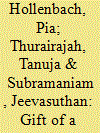

|
|
|
|
|
| Summary/Abstract |
Jaffna District, Sri Lanka, has faced enormous socio-economic difficulties since the civil war ended in May 2009. But in contrast to the visible and apparent infrastructural destruction that characterises much of the District, there is a striking number of newly built Hindu temples. The majority of these new temple constructions are linked to diasporic engagement, philanthropy and giving. Through a Maussian lens, this article provides insights into how the gift of a temple enables people in the diaspora to give something back to local socio-cultural structures, in order to reposition them in relation to their places of origin. However, the Maussian ‘gift’ not only serves the giver; it also impacts on the receiver. The article therefore asks: How does the receiver use these temples? What impact do the temples have on the socio-economic and cultural environment? How are they commodified? Three in-depth case studies will help to provide answers to these questions and to better understand the long-term impact of the gift of temples in post-war Jaffna.
|
|
|
|
|
|
|
|
|
|
|
|
|
|
|
|
| 2 |
ID:
180265
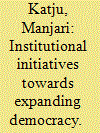

|
|
|
|
|
| Summary/Abstract |
The Election Commission of India (henceforth, the EC), an institution created by the Constitution of India in 1950, manages and conducts parliamentary and state assembly (provincial level) elections. In recent elections, it has made tremendous efforts to make the electoral process more participatory. More than 900 million people were eligible to vote in the Indian parliamentary elections of 2019. In addition to the conventional ways of spreading voter awareness, the EC tried to reach out to voters through previously untried means to persuade them to come to the polling booths and vote – reflecting an institutional enthusiasm for popular mobilisation. However, there are also a significant number of missing names from the electoral rolls, and the EC faces accusations of being apathetic towards this anomaly. Is this eagerness on one hand and anomaly on the other symptomatic of ‘democracy at crossroads’, with India transiting to a more efficacious and involved institutional functioning, or is this an instance of strained institutional performance in the face of rising popular aspirations and tighter executive controls? The paper tries to explore this theme by looking at the functioning of the EC and its efforts towards voter participation in India.
|
|
|
|
|
|
|
|
|
|
|
|
|
|
|
|
| 3 |
ID:
180273


|
|
|
|
|
| Summary/Abstract |
This paper focuses on women of Indian, Bangladeshi and Pakistani origin in the US diaspora to examine how religious identities unfold within multi-layered transnational structures that range from political histories and events to active webs of family and community relationships that stretch across the diaspora. Our analysis draws on focus groups and interviews with highly educated Hindu and Muslim women in the US. For these women, approaches to religion were marked by multiple points of tension and negotiation, including the work of situating oneself within the intersecting power structures of the diaspora and country of origin, including a transnational sphere that is increasingly crafted through the reach of social media. These women's narratives show they are minorities in the US, and part of majorities in countries of origin, but, sometimes, outsiders to the local politics of religions. Focusing on these women allows us to reflect on the ways in which histories and contemporary events shape contemporary South Asia far beyond its geographic location.
|
|
|
|
|
|
|
|
|
|
|
|
|
|
|
|
| 4 |
ID:
180269


|
|
|
|
|
| Summary/Abstract |
Social distance,’ and ‘social distancing’ have become the linguae francae of our world ravaged by COVID-19. Pandemic related social distancing prescriptions, however, do not operate in a vacuum. How do social distancing strategies for containing the pandemic intersect with extant social divisions? Using a unique census-scale micro-dataset from rural Karnataka (an Indian state as large as France), we meditate on this question by drawing on theoretical insights from multiple disciplines including the intellectual genealogy of ‘social distance’ as a measure of social divisions. Our rich dataset contains independent India’s first census-scale enumeration (n ≈ 36.5 million) and coding of elementary caste categories (≈700 jatis). Our dataset is also the first to combine self-reported jati and religion information. To the best of our knowledge, we present the first systematic large-n portrait of intra-village residential segregation in rural India. Our micro-segregation analysis along jati and religion axes provides evidence for a ‘permanent cordon sanitaire.’ Our analysis also sheds light on how the pandemic intersects with internal migration trajectories in India.
|
|
|
|
|
|
|
|
|
|
|
|
|
|
|
|
| 5 |
ID:
180271
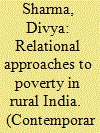

|
|
|
|
|
| Summary/Abstract |
Poverty is now widely recognised as multidimensional, with indicators including healthcare, housing and sanitation. Yet, relational approaches that foreground political-cultural processes remain marginalised in policy discourses. Focusing on India, we review a wide range of relational approaches to rural poverty. Beginning with early approaches that focus on structural reproduction of class, caste and to a lesser extent gender inequality, we examine new relational approaches developed in the last two decades. The new approaches examine diverse ways in which poverty is experienced and shapes mobilisations against deprivation. They draw attention to poor people’s own articulations of deprivation and alternate conceptions of well-being. They also show how intersecting inequalities of class, caste and gender shape governance practices and political movements. Despite these important contributions, the new relational approaches pay limited attention to technologies and ecologies in shaping the experience of poverty. Reviewing studies on the Green Revolution and wider agrarian transformations in India, we then sketch the outlines of a hybrid relational approach to poverty that combines socio-technical and -ecological dynamics. We argue that such an approach is crucial to challenge narrow economising discourses on poverty and to bridge the policy silos of poverty alleviation and (environmentally) sustainable development.
|
|
|
|
|
|
|
|
|
|
|
|
|
|
|
|
| 6 |
ID:
180275
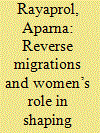

|
|
|
|
|
| Summary/Abstract |
The paper is based on ethnographic observations of religious practices among Muslim return migrants from the Gulf, and among Hindu return migrants from the United States. The goal of these observations was to understand the ways that diasporic cultures have transformed these migrants’ religious practices after they return to India. We focus on the city of Hyderabad, in South India, with its long history of diverse Muslim communities, and recent histories of migration and reverse migration to the Gulf region in Western Asia, as well as recent transformations through the growth of gated communities that have attracted Hindu reverse migrants from the United States. We focus on women’s engagement with religious cultural practices and the ways in which religion and gender are restructured through the process of migration and reverse migration.
|
|
|
|
|
|
|
|
|
|
|
|
|
|
|
|
| 7 |
ID:
180274
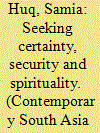

|
|
|
|
|
| Summary/Abstract |
Bangladesh has made significant strides on women’s issues in the areas of education, employment and politics. In the wake of this progress, the country has also experienced a surge of religious ideas leading to secular anxiety that cultural Islamization is leaving very tangible marks on the bodies and lives of women. The proliferation of the hijab along with an appropriation of other religio-cultural elements into everyday life is considered to be an example of the force of Islamization that many fear to be conducive to radicalization. In this paper, I probe the role of religion in the lives of female university students in an attempt to assess what it means for them to be young, to have aspirations, to navigate different and often opposing expectations, and to assert their agency as they stand on the cusp of adulthood. In teasing out the influences that give their lives’ navigations religious sanctions and/or approvals, I trace the place of inclusivity, pluralism and tolerance in the lives of young, educated women in Bangladesh.
|
|
|
|
|
|
|
|
|
|
|
|
|
|
|
|
| 8 |
ID:
180266
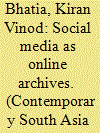

|
|
|
|
|
| Summary/Abstract |
In this ethnographic study I demonstrate how students, teachers, and parents use the affordances of social media platforms to insert religious identities within educational spaces, learning experiences, and classroom interactions. This study was conducted in three schools in tier-I cities of India. The aim of this study was to examine the role of parents and teachers in socializing young students to perform their religious identities while engaging with both educational content and their classmates from a different religious community. In this paper, I argue that social media networks are largely used by individuals to reactivate the existing discursive-discriminatory practices which populate the already dense and politicized mediascapes in cities of India.
|
|
|
|
|
|
|
|
|
|
|
|
|
|
|
|
| 9 |
ID:
180268


|
|
|
|
|
| Summary/Abstract |
Islam is the key character of Pakistan’s national identity, but ironically, it has also become a tool used by different sectarian/jihadi outfits to perpetrate violence against different religious minorities in Pakistan. The targeted persecution of the Hazara Shia community in Balochistan certainly stands among such cases. Since 2003, a Sunni militant group, Lashkar-e-Jhangvi (LeJ), has been perpetrating targeted violence against the Hazara Shias in Balochistan. This paper explores why LeJ has been waging targeted violence against the Hazara community. Is it motivated solely by anti-Shia hatred or are other factors, such as local-level socio-political and economic grievances and the changing regional security environment, also playing a part in exacerbating the violence? The analysis reveals that although Sunni-Shia sectarian dimensions and regional geopolitical factors are still relevant in explaining the targeted persecution of Hazaras, they are no longer the sole instrumental causes behind the violence. It demonstrates that local level disputes over socio-economic resources and access to political power have now become more significant, to the extent that they are transforming the relationship between Sunni sectarian outfits and local ethnic communities in Balochistan, thus creating incentives for militant groups to promote religious hatred and sectarian intolerance.
|
|
|
|
|
|
|
|
|
|
|
|
|
|
|
|
| 10 |
ID:
180267
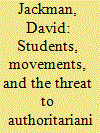

|
|
|
|
|
| Summary/Abstract |
Decades of violent yet competitive party politics in Bangladesh have been usurped by authoritarian consolidation under the ruling Awami League. Both mainstream ‘civil society’ and political opposition have been largely suppressed, left unable to wage the protests typical of the county’s politics. It is then striking that recent years have nonetheless seen significant urban unrest in the form of student led movements, coalescing around issues of injustice. Such social movements are neglected in the study of authoritarian durability, yet appear in practice to pose a serious threat to the ruling party. To understand this threat, this article examines two cases from 2018: the movements for reform to civil service quotas, and improved road safety. It argues such movements must be read in light of Bangladesh’s history, where students have played a major role in confronting authoritarian rule. In particular, they pose two threats: first, they have the potential to undermine the ruling party’s legitimacy and create a moment of crisis on which the opposition could capitalise; second, they can exacerbate tensions between interest groups on whom the ruling party rely to maintain power. Responding to such threats is thus crucial for the ruling party to maintain their grip on power.
|
|
|
|
|
|
|
|
|
|
|
|
|
|
|
|
| 11 |
ID:
180272


|
|
|
|
|
| Summary/Abstract |
This viewpoint essay provides an introduction to the special section, ‘Lived Religions of South Asian Hindu and Muslim Women' and context on the issues for the readers. The section draws on the work of an interdisciplinary, international group and covers a vast swath from return migrant women’s locations within Hinduism and Islam in Bangladesh and India, to their experiences with religion in the U.S. and the Middle East. It also examines alternative, emancipatory Hindu traditions, and women’s struggles with India’s Citizenship Amendment Act. I provide an overview to role of religion in shaping anti-colonial nationalist movements, post-colonial national identities, as well as the rise of religious fundamentalisms in South Asia. I also draw on my own work to show how religion mediates out-migration, settlement, and community formation of South Asians in the diaspora and the contradictory impacts religion has on women’s lives. I examine how the diasporization of religion often results in a greater intellectualization as well as homogenization and can encourage both religious fundamentalisms as well as a recasting of religious doctrines to fit in with the culture and society of the new countries. Finally, I discuss the multi-directional relationship between religious exchanges among diasporic and home communities.
|
|
|
|
|
|
|
|
|
|
|
|
|
|
|
|
| 12 |
ID:
180278
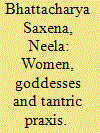

|
|
|
|
|
| Summary/Abstract |
While modern India is complex, plural and perhaps foundationally connected with its rich liberatory paths, there is reason to be concerned when a large number of people are fed hate-filled rhetoric against their own long-term neighbors. Today the virulent ideology of a purported “Hindu” rashtra is growing under governmental provocation. It needs an alternative vision which can be resurrected from India's own suppressed history. That is Tantric India, whose liberatory paths with women and goddesses is compatible with the contemporary world. India has been a magnet for “spiritual” seekers around the world because the great sages were helping to free us from our conditioned selves. This worldview, that encompassed all Indic dharmas, was developed especially by Shaiva, Shakta and Buddhist enlightened beings, and was set against an upper caste hegemony of truncated Vedism. The true masters who developed a real science of tantric praxis taught how to appreciate the world here and now without violence to the self, earth or the perceived other. From ancient yogic explorations of humanistic psycho-spiritual development that has been a hallmark of India, a profoundly egalitarian world view had developed during 8th through 12th centuries. It is time we reexamine that history and imagine a different Subcontinent.
|
|
|
|
|
|
|
|
|
|
|
|
|
|
|
|
| 13 |
ID:
180277


|
|
|
|
|
| Summary/Abstract |
In 2019, India passed the Citizenship (Amendment) Act (CAA), providing Indian citizenship to immigrants, with the exception of Muslims, from the neighboring countries of Pakistan, Afghanistan, and Bangladesh. In this viewpoint essay, I examine the CAA and the protests that it has generated, with particular attention to intersecting dynamics of gender, religion and citizenship. Muslim women have protested the CAA with assertions of their identity as Indians and Muslims; they have deployed the tropes and symbols of a secular, non-majoritarian and democratic India, and the values that are enshrined in the Constitution. Other constituencies, united in their resistance to exclusionary laws and rhetoric, have also supported the CAA protest movement. My conversations from the field show the particular vulnerabilities of women to a state bureaucracy that expects citizens to produce official identity documents without regard to complex histories of displacement and gender inequality.
|
|
|
|
|
|
|
|
|
|
|
|
|
|
|
|
|
|
|
|
|